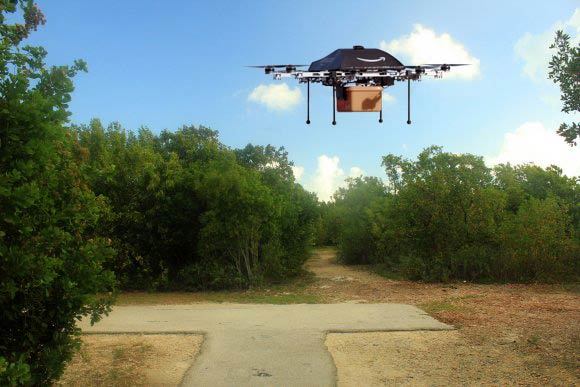Traveling Sales Drone

Amazon is testing out their new Prime Air service, and they want to plot a path for the drone to make its deliveries.
Dispatch center: ( 0 , 0 )
Packages: ( 7 , 9 ) , ( − 9 , 7 ) , ( 1 , 2 2 ) , ( − 6 , 1 9 ) , ( − 8 , 1 ) , ( 0 , 1 )
Assuming that the coordinates given are in km, what is the minimum distance the drone must travel to deliver all the packages and return to dispatch (rounded to the nearest km)?
The answer is 60.
This section requires Javascript.
You are seeing this because something didn't load right. We suggest you, (a) try
refreshing the page, (b) enabling javascript if it is disabled on your browser and,
finally, (c)
loading the
non-javascript version of this page
. We're sorry about the hassle.
5 solutions
Discussions for this problem are now closed
You can use Euclidean distance to calculate the distance between two points in a Graph!
Can you formally prove the "they look shorter" part?
You can use triangle inequality in geometry to prove that the diagonals are longer than the sides.
It looks like your first path sums up to about 60.75, but I could easily be mistaken.
The second path is indeed the shortest.
The simplest way to do this problem is to simply bash through all the possibilities and calculate the distance for each.
Python solution:
import itertools
p = [(7,9),(-9,7),(1,22),(-6,19),(-8,1),(0,1)]
ans = float('inf')
for i in itertools.permutations(p):
l = (0,0)
d = 0
for x in i:
d += ((x[0] - l[0]) ** 2 + (x[1] - l[1]) ** 2) ** 0.5
l = x
d += (i[-1][0] ** 2 + i[-1][1] ** 2) ** 0.5
if d < ans:
ans = d
But isn't the complexity exponential then...
No; it's O(n!), which is worse (O(c^n) is with dynamic programming), but it works finely for small cases like the one described in the problem.
Using Python itertools module, as others have done, but used the sympy geometry abilities too, which saves the need to write Euclidean distance code.

Python Solution:
import itertools
class coordinate(object):
def __init__(self, x, y):
self.x = x
self.y = y
self.conquered = False
def getX(self):
return self.x
def getY(self):
return self.y
def __str__(self):
return '(' + str(self.x) + ', ' + str(self.y) + ')'
def buildCoordinates():
return [coordinate(7,9), coordinate(-9,7), coordinate(1,22), coordinate(-6, 19), coordinate(-8, 1), coordinate(0, 1)]
def dis(co1, co2):
'''
Returs distance between 2 coordinates
'''
return ((co1.getX() - co2.getX())**2 + (co1.getY() - co2.getY())**2)**0.5
def totDis(allCoordinates):
totalDistance = 0
for i in range(len(allCoordinates) - 1):
totalDistance += dis(allCoordinates[i], allCoordinates[i + 1])
totalDistance += dis(allCoordinates[0], coordinate(0, 0))
totalDistance += dis(allCoordinates[-1], coordinate(0, 0))
return totalDistance
bestDistance = 1000
allRoutes = list(itertools.permutations(buildCoordinates()))
for i in allRoutes:
if totDis(i) < bestDistance:
bestDistance = totDis(i)
print bestDistance
Python code:
import math
cities=[(7,9),(-9,7),(1,22),(-6,19),(-8,1),(0,1)]
min_dist = 100000000000000
def explore(visited, total_distance):
global cities, min_dist
if len(visited) == 7:
min_dist = min(min_dist, total_distance + math.sqrt(visited[-1][0]**2 + visited[-1][1]**2))
return
for city in cities:
if city not in visited:
explore(visited + [city], total_distance + math.sqrt((city[0] - visited[-1][0])**2 + (city[1] - visited[-1][1])**2))
explore([(0, 0)], 0)
print min_dist
i am getting 58 and have no idea y
int min=999;
void fx1(int set[10],int arr[10][10],int pat[10],int co,int c,int n,int j,int fin[10]){
int i;
if (c==n) {
printf("\n%d\n",co+arr[j][0]);
for (i=0; i<=n; i++) {
printf(" %2d ",pat[i]);
}
printf("\n");
for (i=0; i<=n; i++) {
printf(" %2d ",arr[pat[i]][pat[i-1]]);
}
printf("\n");
//-----
if (co+arr[j][0]<min) {
min=co+arr[j][0];
for (i=0; i<=n; i++) {
fin[i]=pat[i];
}
}
}
for (i=0; i<n; i++) {
if (set[i]==0) {
set[i]=1;
pat[c]=i;
c++;
fx1(set, arr, pat, co+arr[j][i], c, n, i,fin);
set[i]=0;
c--;
}
}
// printf(")");
return;
}
int main(){
int set[10]={0},arr[10][10]={0},pat[10]={0},fin[10]={0},c,n,j,i;
printf("\n Enter the n\n");
scanf("%d",&n);
c=0;
for (i=1; i<n; i++) {
for (j=0; j<i; j++) {
printf("i=%d j=%d\n",i,j);
scanf("%d",&arr[j][i]);
arr[i][j]=arr[j][i];
}
}
for (i=0; i<n; i++) {
printf("\n");
for (j=0; j<n; j++) {
printf("%2d\t",arr[i][j]);
}
}
c=1;
set[0]=1;
fx1(set, arr, pat, 0, c, n, 0,fin);
printf("the final min path is ->\n");
printf("\n%d\n",min);
for (i=0; i<=n; i++) {
printf(" %d ",fin[i]);
}
}
Are you going back to the dispatch point in the end?
It appears you are truncating each path length, instead of calculating the length as a double, adding them up and approximating the result.
Nicely Named as Travelling Sales Drone!! Yes the problem sounds akin to the "Travelling Sales Man" problem..
We can name the points as A,B,C,D,E,F in the order they appear ! Just plotting the points on a graph roughly gives you a picture like this
From that we can deduce that there can be 2 possible routes (that look shorter). They are ,
Origin -> F -> E -> B -> D -> C -> A -> Origin
Origin -> E -> B -> D -> C -> A -> F -> Origin
The first one sums upto 69.6 which can be rounded to 69 !
The second one sums upto 60.05 which can be rounded to 60 !